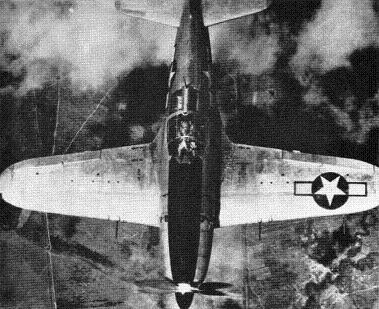![]() The Pacific War Online Encyclopedia
The Pacific War Online Encyclopedia
|
| Previous: J2F Duck, U.S. Reconnaissance Seaplane | Table of Contents | Next: J3 Class, Japanese Submarines |

Captured J2M3 in American colors. U.S. Navy. Via Francillon (1979).
Mitsubishi J2M2 Raiden ("Thunderbolt") "Jack"
|
Crew |
1 |
|
Dimensions |
35’5” by 31'6" by 12'7" 10.8m by 9.695m by 3.875m |
| Wing area | 216
square feet 20.1 square meters |
|
Weights |
5176-7077 lbs 2348-3210 kg |
|
Maximum speed |
371 mph at 17,880 feet 597 km/h at 5300 meters |
|
Cruising speed |
219 mph 352 km/h |
|
Climb rate |
58 feet per second 17.7 meters per second |
|
Service ceiling |
36,090 feet 11,000 meters |
| One 1800 hp (1342 kW) Mitsubishi MK4R-A Kasei 23a fourteen-cylinder air-cooled radial engine driving a four-blade constant-speed metal propeller. | |
|
Armament |
Two wing-mounted 20mm Type 99 Model 2
cannon Two 7.7mm Type 97 machine guns above the fuselage |
|
External stores |
Two 60 kg (132 lb) bombs or two 44 gallon (167 liter) drop tanks. |
|
Normal range |
1180 miles 1900 km |
| A total of 476
aircraft were built by Mitsubishi Jukogyo K.K. from December 1943. In addition, a number of J2M5s were built by the Koza Kaigun Kokusho (Koza Naval Air Arsenal). Production at Mitsubishi's Nagoya and Suzuka plants was as follows: 3
J2M1 prototypes |
|
|
Variants |
The J2M3 was armed
with two Model 1 and two Model 2 wing cannon. The J2M3a
had four Model 2 wing cannon. The J2M5 introduced an 1820 hp (1357 kW) MK4U-A Kasei 26a engine and was armed with only two wing cannon. Its engine was, however, much more reliable, and it performed well against B-29s. |
Designed as a bomber interceptor,
Jack was armored,
had adequate firepower, and sacrificed some maneuverability for speed
and climb
rate. Like the Mustang,
the Jack used small
laminar-flow wings with combat flaps. The engine was given an unusually
long shaft to allow the use of a tapered cowling with reduced drag. The
initial canopy design, which was meant to reduce drag as much as
possible, was replaced with a more conventional flat panel canopy after
early test pilots complained of distorted vision on landing.
The design went back to 1938, but was put on the back shelf in favor of development of the A6M Zero. As a result, the first prototype was not completed until February 1942. Production was approved in October 1942, but the Kasei engine gave continuing difficulties, and this kept the production rate very low for the first six months. This was just as well, as it was only then discovered that a defect in the tail wheel strut sometimes jammed the tail surfaces in the dive position, usually with fatal consequences.
In spite of continuing technical problems, the Jack seems to have been liked by those who flew it, and it became the favorite bomber destroyer of Japanese pilots. Most were retained in the home islands, but a small number were sent to the Philippines. Production was planned at 500 a month, but actual production never came close to this figure.
References
The Pacific War Online Encyclopedia © 2007, 2009 by Kent G. Budge. Index